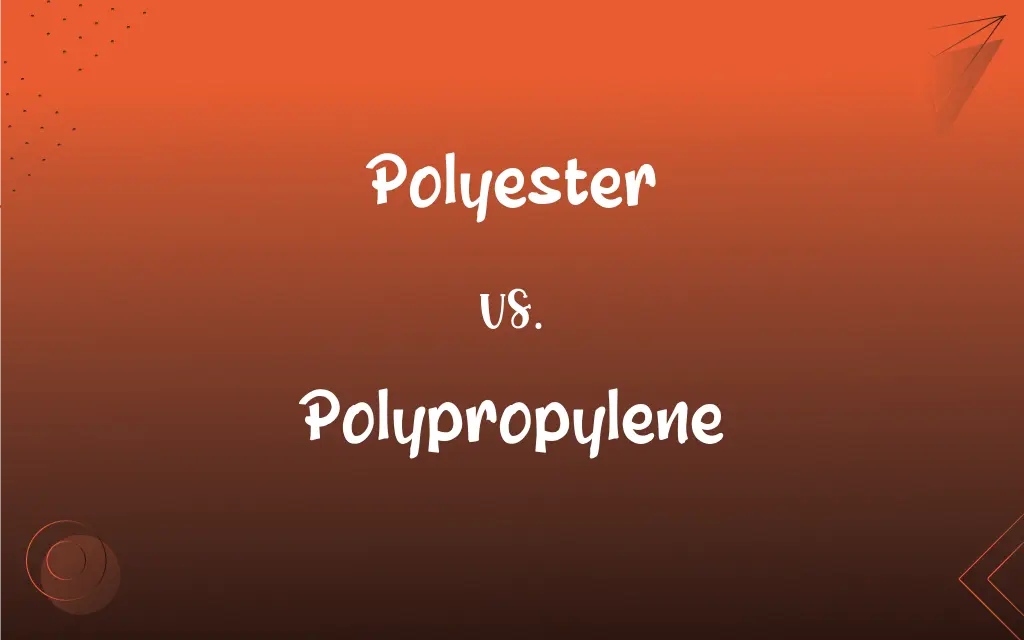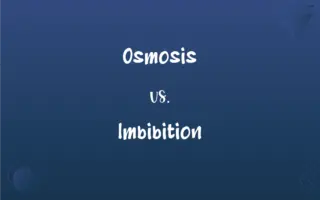Polyester vs. Polypropylene: What's the Difference?
Edited by Janet White || By Harlon Moss || Updated on October 14, 2023
Polyester is a durable and stretchy synthetic fabric, while polypropylene is a tough, heat-resistant thermoplastic polymer. Both are used widely in various industries due to their unique properties.

Key Differences
Polyester, recognized for its durability, is extensively utilized in the textile industry. Polypropylene, on the other hand, boasts of its resistance to chemical and organic solvents, situating itself as a common material in packaging and containers. Both materials present themselves as indispensable in their respective sectors, often being chosen for their specific strengths and resistances.
Polyester offers a level of comfort and is often used in clothing due to its resistance to wrinkles and quick-drying properties. Polypropylene is inherently hydrophobic, repelling water and effectively floating on its surface, making it useful in applications requiring moisture resistance. The distinct behaviors towards water and moisture set them apart in applications that require particular interactions with liquids.
In the realm of sustainability, polyester can be recycled relatively easily, contributing to environmentally conscious production practices. Polypropylene, being robust and lightweight, is also recyclable and is frequently utilized in automotive and industrial components, offering a lightweight alternative without compromising strength. Both materials showcase a commitment to reusability and recycling, albeit used in different contexts and products.
When considering applications in daily life, polyester frequently appears in household items like curtains, bed sheets, and apparel. In contrast, polypropylene commonly surfaces in plastic containers, garden products, and disposable bottles, punctuating its presence in various aspects of domestic life. Both materials embed themselves in day-to-day living, providing functionalities that cater to comfort and practicality in divergent ways.
In an industrial context, polyester often finds its way into high-strength ropes, conveyor belts, and safety belts, underlining its strength and durability. Polypropylene, owing to its high melting point and moldability, is widely used in creating automotive parts and industrial fibers. Both materials stake claims in the industrial sector, playing pivotal roles in manufacturing and production across diverse applications.
ADVERTISEMENT
Comparison Chart
Word Length
9 letters
12 letters
Syllables
3 syllables
4 syllables
First Letter
P
P
Vowels
3 vowels
4 vowels
Common Use in Industry
Textiles and fabrics
Packaging and containers
ADVERTISEMENT
Polyester and Polypropylene Definitions
Polyester
Polyester is a synthetic resin which is used to make synthetic textile fibers.
My new shirt is made of 100% polyester and is incredibly lightweight.
Polypropylene
Polypropylene is notable for its chemical resistance and is often used in packaging.
The polypropylene bottle safely stores the aggressive cleaning chemical.
Polyester
Polyester can refer to any polymer whose monomer unit involves an ester group.
Polyester resins are used in the production of high-quality, clear plastics.
Polypropylene
Polypropylene can be utilized in injection molding applications due to its moldability.
Toys are often made using polypropylene because it can be molded into intricate shapes.
Polyester
Polyester fabrics are utilized for their resistance to wrinkles and stains.
The tablecloth is made from polyester to ensure it remains wrinkle-free and easy to clean.
Polypropylene
Polypropylene is a durable, heat-resistant thermoplastic polymer.
The container is made of polypropylene to withstand microwaving.
Polyester
Polyester fibers are known for their ability to retain their shape and resist shrinkage.
Polyester curtains maintain their appearance after washing due to their resistance to shrinkage.
Polypropylene
Polypropylene fibers are used in textiles due to their hydrophobic properties.
The outdoor rug, made from polypropylene, doesn’t absorb water and resists mildew.
Polyester
Polyester is recognized for being durable, often used in long-lasting outdoor fabrics.
The outdoor tent is crafted from polyester to endure various weather conditions efficiently.
Polypropylene
Polypropylene is a popular choice for disposable containers due to its cost-effectiveness.
The disposable meal boxes are made of polypropylene to keep costs low while providing durability.
Polyester
Any of numerous synthetic polymers produced chiefly by reaction of dicarboxylic acids with dihydric alcohols and used primarily as light, strong, weather-resistant resins in boat hulls, textile fibers, adhesives, and molded parts.
Polypropylene
Any of various thermoplastic polymers of propylene. They are hard and tough, and are used to make molded articles and fibers.
Polyester
A wrinkle-resistant fabric of fibers made from any of these resins.
Polypropylene
A fabric of fibers made from any of these polymers.
Polypropylene
A thermoplastic resin made by the polymerization of propylene, and used for films, fibres, or moulding materials. Also known as polypropene.
Polypropylene
A polymer of propylene used as a thermoplastic molding material
FAQs
Can polyester be used for outdoor products?
Yes, polyester's durability and resistance to various weather conditions make it suitable for outdoor use.
How does polyester fabric feel to the touch?
Polyester can have a smooth and lightweight feel but may vary depending on the weave and finish.
How is polyester produced?
Polyester is produced by polymerizing ethylene glycol and terephthalic acid, creating long polymer chains.
Can polypropylene be recycled?
Yes, polypropylene is recyclable and typically carries the recycling symbol “5.”
Are polyester fabrics comfortable for summer wear?
While polyester can wick moisture, it may not be as breathable as natural fibers, affecting comfort in hot weather.
Can polypropylene be used in high-temperature applications?
Polypropylene has a moderate heat resistance but may not be suitable for high-temperature applications due to its lower melting point.
Is polypropylene used in medical devices?
Yes, polypropylene is used in various medical devices due to its stability and non-reactive nature.
How is polypropylene manufactured?
Polypropylene is produced through the polymerization of propylene gas using a catalyst system.
Can polypropylene be used in 3D printing?
Yes, polypropylene can be used as a filament in 3D printing due to its moldable nature.
How does polyester react to UV light?
Polyester can resist UV light to a degree but may degrade with prolonged exposure.
What are common uses of polyester in textiles?
Polyester is widely used in clothing, bedding, and other fabric products due to its durability and wrinkle resistance.
Is polypropylene considered safe for food packaging?
Yes, polypropylene is generally considered safe for food packaging and is commonly used for containers.
What is the melting point of polyester?
Polyester typically has a melting point of around 250–260 degrees Celsius (482–500 degrees Fahrenheit).
Can polyester be blended with natural fibers?
Yes, polyester is often blended with cotton and other natural fibers to enhance durability and retain comfort.
Are polypropylene products microwave safe?
Polypropylene is often deemed microwave-safe, but it's crucial to check product specifications to ensure safety.
Why is polypropylene popular in packaging?
Polypropylene is favored in packaging due to its chemical resistance, lightness, and durability.
Does polyester clothing shrink in the wash?
Polyester is resistant to shrinkage and generally maintains its shape when washed.
What are some disadvantages of using polypropylene?
Polypropylene can be susceptible to UV degradation and has a lower melting point compared to some plastics.
What industries heavily utilize polypropylene?
The automotive, textile, packaging, and healthcare industries utilize polypropylene due to its versatile properties.
Is polyester a sustainable material?
Polyester can be recycled, and there are developments in creating it from recycled materials, enhancing its sustainability.
About Author
Written by
Harlon MossHarlon is a seasoned quality moderator and accomplished content writer for Difference Wiki. An alumnus of the prestigious University of California, he earned his degree in Computer Science. Leveraging his academic background, Harlon brings a meticulous and informed perspective to his work, ensuring content accuracy and excellence.
Edited by
Janet WhiteJanet White has been an esteemed writer and blogger for Difference Wiki. Holding a Master's degree in Science and Medical Journalism from the prestigious Boston University, she has consistently demonstrated her expertise and passion for her field. When she's not immersed in her work, Janet relishes her time exercising, delving into a good book, and cherishing moments with friends and family.































































